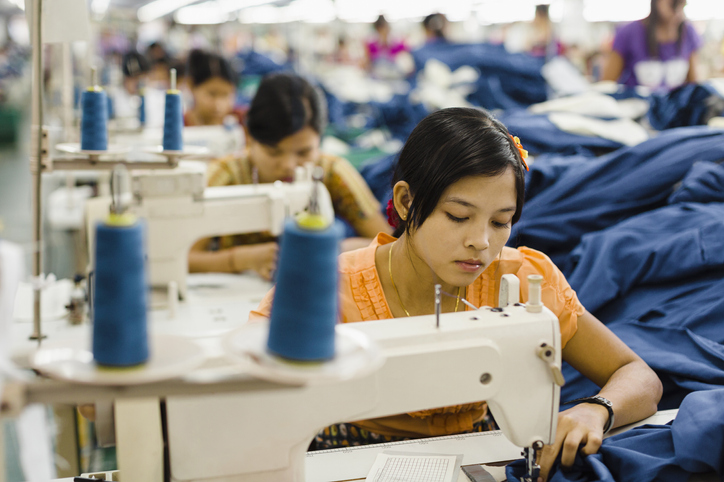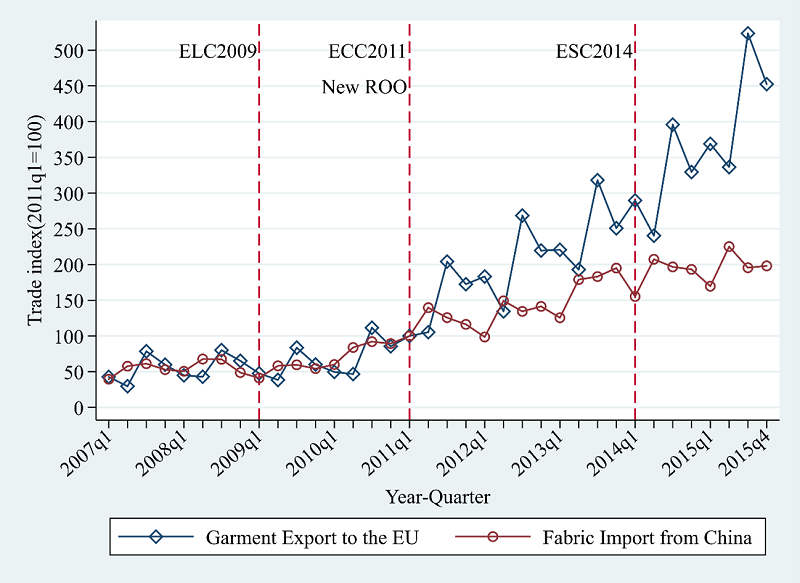IDE Research Columns
Column
How Does Trade Affect Formal and Informal Jobs?

Kiyoyasu TANAKA and Theresa M. GREANEY
Institute of Developing Economies; University of Hawaii
February 2024
How does trade affect formal and informal jobs in developing economies? We estimate the impact of exports on employment in the formal and informal sectors by exploiting the European Union (EU)’s reform in rules of origin for duty-free market access, which produced a large positive shock to Cambodia’s garment exports to the EU (Tanaka and Greaney 2024). We find that the export shock caused large employment growth in formal garment establishments but had little effect on employment in informal garment establishments. The positive effect is pronounced for incumbent establishments and female workers. Thus, trade promotes employment disproportionately in the formal sector.
Informal Jobs in Developing Economies
A large number of workers in developing economies find employment opportunities in the informal sector such as self-employment, household enterprises and other small businesses. Informal jobs provide short-run labor market flexibility, but correlate with lower wages and tax revenues, and higher poverty, inequality, and job insecurity (La Porta and Shleifer 2014). Meanwhile, formally registered firms provide better employment opportunities through formal labor contracts, statutory minimum wages and other workplace regulations. Promoting formal jobs in export industries can facilitate labor reallocation from informal to formal employment. Thus, the effect of trade on employment in the formal and informal sectors is a key question in economic development.
How Do We Estimate the Causal Impact of Trade?
Estimating the impact of trade on employment appears to be easy at a glance, but finding the causal impact is actually challenging. Why? A reason is that employment often changes with trade, and a positive or negative correlation between them may simply capture an endogenous relationship.1 To this end, we exploit a natural experiment from Cambodia: a policy shock involving Cambodia’s garment exports to the EU. The garment industry is Cambodia’s largest export industry, accounting for 77.7% of total merchandise exports in 2014, according to the UN COMTRADE database. The EU granted Cambodia duty-free and quota-free access under the Everything But Arms (EBA) initiative in 2001, and then simplified the rules of origin (ROO) for their Generalized System of Preferences (GSP) in 2011. Under the new ROO, garment exporters can use imported fabric from any third country and still maintain preferential access to the EU. Consequently, garment exports from Cambodia to the EU increased sharply from 2011, which coincided with a rapid increase in Cambodia’s fabric imports from China. As Cambodia had little effective influence on the EU’s reform process in the GSP ROO, this reform was an exogenous, sudden, and quantitatively large positive shock to garment exports in Cambodia, providing an ideal natural experiment to identify the causal impact of a positive export shock on employment in the garment industry.

Figure 1. Garment Exports to the EU and Fabric Imports from China in Cambodia
Notes: Trade values are normalized to take on a value of 100 for the first quarter in 2011; a diamond marker indicates the index of Cambodia’s garment exports in Harmonized System (HS) Chapters 61 and 62 that entered the EU markets for duty-free access; a circle marker shows the index of Cambodia’s fabric imports from China, including HS codes 5208-12, 5309-11, 5407-08, 5512-16, 5901-11, 6001-06; ELC2009, ECC2011, and ESC2014 indicate the survey dates for the Establishment Listing in 2009, Economic Census in 2011, and Inter-censal Economic Survey in 2014, respectively.
Source: Authors’ calculation using EUROSTAT and Global Trade Atlas.
How Do We Observe Informal Jobs?
Data on informal jobs are typically missing in developing economies. While sample surveys on the informal sector have been conducted in many developing economies, to the best of our knowledge, comprehensive statistics on both formal and informal sectors are not readily available. To this end, we exploit a unique dataset on both formal (i.e., registered) and informal (i.e., unregistered) establishments in Cambodia. Specifically, we use three sets of establishment-level data for the formal and informal sectors: the Establishment Listing of Cambodia (ELC) in 2009, the Economic Census of Cambodia (ECC) in 2011, and the Inter-censal Economic Survey of Cambodia (ESC) in 2014. The ELC and ECC cover all nonfarm establishments across all industrial sectors in all areas of Cambodia, whereas the ESC is a nationally representative survey. These surveys ask whether individual establishments register with the Ministry of Commerce. Unregistered economic activity is a commonly used definition of informality, and business registration is an objective criterion to classify formal and informal economic activities (Schneider and Enste 2013). Our dataset is advantageous in that we can estimate heterogeneous trade effects on both formal and informal establishments.
How Do Formal and Informal Sectors Respond to an Export Shock?
The EU’s reform in ROO reduced production and trade costs for the garment industry in Cambodia and promoted employment in that industry through an expansion of EU-bound garment exports. However, trade-policy changes may have different impacts on formal and informal firms because formal firms are more productive than informal firms, and institutional barriers prevent informal firms from directly engaging in exporting. In the case of the EU GSP, exporters must obtain a certificate of origin (CO) document to certify the origin of their shipped products upon entering the EU markets. Since the CO document is issued only to legally established enterprises, preferential market access is open only to formally registered firms. Therefore, we estimate potentially heterogeneous export effects between formal and informal firms in the garment industry.
Employment Effects of Trade
We find large positive employment effects on formal garment establishments, but little effect on informal garment establishments. In our baseline estimate, the treatment effect of the export shock is 137.4 additional workers in 2014 for formal garment establishments. Since they employed 645.4 workers on average in 2011, the treatment effect amounts to a 21.3% increase in establishment-level employment between 2011 and 2014. The positive employment effects are more pronounced for incumbent formal establishments and female workers. Additionally, the benchmark results are robust to possible differential trends in employment between treated and control industries during the pre-reform period and to the possible influence of outlier (i.e., very large or small) formal establishments. Placebo tests indicate that the significant employment growth is not a commonly observed pattern for other industries in Cambodia. Finally, we explore whether firm transitions from informal to formal drive our results and provide evidence against this hypothesis.
Implications
The large export and employment growth in Cambodia’s formal garment firms after the EU relaxed the ROO in its GSP suggests that such ROO should be carefully considered based on the economic status of beneficiary countries and their ability to take advantage of the trade preferences being offered. Under the original strict ROO, Cambodia’s garment industry was required to use fabric sourced domestically or from the EU or ASEAN countries to qualify for duty-free access to the EU markets. This restriction contributed to the under-utilization of preferential access because the specified fabric sources were not cost-effective compared with those from China, Hong Kong, Taiwan, and South Korea. Cambodia’s garment industry expanded through greater utilization of preferential access to the EU markets only after it was allowed to source the needed fabric inputs from the most competitive sources.
Further Research Directions
Further research using firm-level and/or worker-level data is needed to improve our understanding of the linkages between trade and employment in the formal and informal sectors in developing economies. While we find large positive employment effects on formal garment establishments and no significant effects on their informal counterparts in Cambodia, we acknowledge that our firm-level data may miss employment adjustments that occur to the number of hours worked and/or by industry exit of establishments. Also, the origin of newly hired workers in the garment industry is unexplored in our study. Moving “surplus” labor (e.g., teenage girls and young women) out of agriculture and into manufacturing is part of a standard industrialization path, while shifting migrant workers from rural to urban areas accompanies a rapid urbanization process. Worker-level data can shed light on these issues.
Author’s Note
This Column is based on Tanaka, Kiyoyasu, and Theresa M. Greaney. 2024. “Trade and Employment in the Formal and Informal Sectors: A Natural Experiment from Cambodia.” Journal of Asian Economics 90: 101676. https://doi.org/10.1016/j.asieco.2023.101676
Note:
- It is difficult, if not impossible, to conduct a randomized experiment that generates exogenous variation in export and/or import for firms and industries. See Atkin, Khandelwal, and Osman (2017) for such an experiment on the relationship between exporting and firm performance.
References
Atkin, David, Amit K. Khandelwal, and Adam Osman. 2017. “Exporting and Firm Performance: Evidence from a Randomized Experiment.” Quarterly Journal of Economics 132(2): 551–615.
La Porta, Raphael, and Andrei Shleifer. 2014. “Informality and Development.” Journal of Economic Perspectives 28(3): 109–26.
Schneider, Friedrich, and Dominik H. Enste. 2013. The Shadow Economy: An International Survey. Cambridge: Cambridge University Press.
Tanaka, Kiyoyasu, and Theresa M. Greaney. 2024. “Trade and Employment in the Formal and Informal Sectors: A Natural Experiment from Cambodia.” Journal of Asian Economics 90: 101676. https://doi.org/10.1016/j.asieco.2023.101676
* Thumbnail image: Asian worker sewing clothing in garment factory (Roberto Westbrook/ Getty Images)
** The views expressed in the columns are those of the author(s) and do not represent the views of IDE-JETRO or the institutions with which the authors are affiliated.

